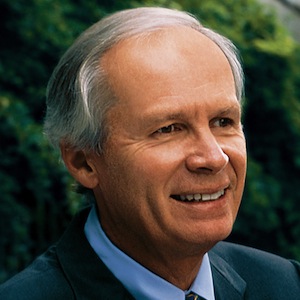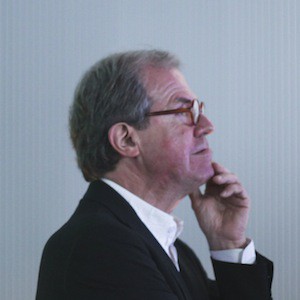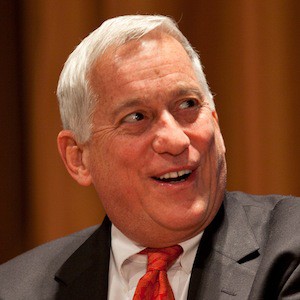Paul Sagan: All right, so, I have to know the date. It is March 4th, 2013. This is Paul Sagan with Martin Nisenholtz and John Huey, and Roger Fidler doing a hangout recording for the oral history that we’re working on at the Shorenstein Center at Harvard. Martin?
Martin Nisenholtz: Thanks so much. Roger, tell us about your background and how you first became involved with information technology.
Roger Fidler: Oh, how much time do you have?
Martin: Well, we have about an hour for the whole interview, and we have 10 questions, so approximately five minutes for this piece.
Roger: I’ll try to keep it short. I guess my first involvement with digital technology and the digital transformation of newspapers began in early 1974 at the St. Pete Times, when they brought in their first Harris standalone editing terminal. From there, I went to Detroit Free Press in May of 1974. I was at the time the only person at the Free Press who would touch a computer. They had these standalone systems that are very primitive by today’s standards that {inaudible} had, but I began playing with it. I was the graphics editor at the time for the Sunday magazine, experimenting with it to see what I could do, finally was actually starting to do even some pagination, having to code it to make it work.
From that point, I began to look to the future and realize that we were going to be bringing computers into newspapers almost every area, and that the next logical step down the road would be to make our content available digitally from the newspaper to the consumer.
Around 1977, went to Knight Ridder’s school where they basically assessed people at Knight Ridder for management positions. One of the things they asked me is what I wanted to do in 5 years or 10 years. I said in five years I thought it’s really important to have a position in corporate dealing with the digital transformation of newspapers, and maybe creating a position of director of newsroom technology and design.
I was of course told that there was no such position, and wouldn’t it be better just to start on a managing editor track, and get me to a small newspaper and move me up that way, and I wasn’t interested.
In 1979, in January, Jim Batten called me actually while I was in Pennsylvania helping to found the Society of News Design, and asked me if I could come to Miami to talk about a new project that they wanted me to be involved in, but he wouldn’t tell me what it was.
I flew to Miami, met with Batten, who told me at the time, “This is our top secret project.” He called it our Manhattan Project, to develop an electronic publishing system that was being developed in England at the time called View Data or VideoText.
He wanted me and this group of three other people that had been chosen to go to England, learn all we could about the Video Tech service, one that was being developed at the time called Prestel, and then come back and help to build a similar system in the United States.
Being a sucker for an opportunity to travel anywhere in the world, the offer to go to England was enough to get me going, but I was certainly excited about the possibility of seeing what this was all about.
In England, I began working with Videotechs view data terminals. Creating the first computer graphics for frames of information to be displayed on a home TV set. These were the early online systems that connected the home TV set to the home telephone, through a modem, and a black box to a database that could have a range of content that people could access through the system.
From 1979 to ’83, I worked on the Viewtron project. I had dual roles, because at the time when we started this, it was a secret project.
We weren’t allowed to talk about what we were doing, because we were afraid at the time, The Times Mirror, and other companies might get a jump on us, so my title became “Corporate Director of Newsroom Technology and Design.” Which is one that I had originally suggested back in ’79. That, and had created that as my cover, but I was also working with newspapers on pagination systems, and redesigning the papers for Knight Ridder at that time.
During that time, in 1981, early ’81, we had a person come to Knight Ridder [inaudible] who had developed at Westinghouse, the first active matrix liquid crystal displays. He was convinced that the future would be thin displays that could be used for portable devices.
He was starting a company called Canolusion, and wanted to know if Knight Ridder would be interested in investing. Batten had me look at the prospectives, to see this first display that was only a couple of inches square. Seeing that I thought, “Yes. If you could have something that was closer to magazine size, maybe this would be the real solution for digital newspapers in the future.”
At the time, you may recall back in the late ’70’s, early ’80’s, there were already people predicting that at some point newspapers would be replaced by digital technology. Paper will be displaced by digital technology, and had concerns about that.
Of course newspaper executives were all worried about what that would mean for their business. So in ’81 there was the APME that invited a number of editors and designers to write an essay and, perhaps, create some images of what they thought newspapers might be like after the year 2000.
So I wrote an essay where my idea was that, by 2000 or soon after that, we would have magazine sized display devices that weighed about a pound, that were thin, with touch screens, instant on, instant off. Very simple to use where you could access newspapers from anywhere in the world as well as books and magazines and other material and created a mock up for that, that was included in that essay.
At the time, everyone thought I was totally crazy. This was total science fiction in the minds of the editors I talked to. I remember, John Woolley, who at the time was the editor of the Viewtron project, said to me something to the effect that that was a “nut ball idea,” that would never happen.
It’s interesting that I’ve received many emails from former Knight Ridder people and people that I had spoken to about this idea for a number of years, who came back and said, “I guess you were right.” It was nice to hear that.
From that point in the 1980s, I stayed with the Viewtron project until it went commercial in 1983. At that point I was thinking about how I could take what I had learned about computer graphics to use that skill and that technology to create information graphics for print.
I convinced Batten that I should go off and find a computer system that would work for that purpose and then develop a service that would provide information graphics to our newspapers. Went out looking, met with people from IBM, Xerox and other companies. None really had a system that was ready to go…
Martin: Can I interrupt for just a second, because I don’t want to skip through Viewtron. It’s come up a couple of times in some of the other interviews. I guess the question that I have is, do you take any lessons from Viewtron? In other words, it was a very bold and costly experiment in the early eighties. But it was shut down. As we all know, it was termed a failure. What lessons did the company or did you learn from that?
Roger: Quite a few. Actually, I wrote a chapter for my book that came out in 1997, called MediaMorphosis, Understanding New Media. The chapter was Lessons from Failure, where I described the project, what we were doing and what we were trying to accomplish. And that we were, essentially, in that first wave of online development. One of the lessons, of course, is when you are developing any new technology, those who are involved in the project believe things will move much more quickly than they actually will. It’s just normal human nature for things to take a while before they catch on. Paul Saffo, at The Institute For The Future, talks about his 30 year rule.
That usually in the first decade of a new technology, as it comes out of the lab, not a lot of understanding about it, there’s not an audience prepared for it. Often, that first wave fails. The second decade, a newer technology emerges, people are becoming more aware of it. It starts to take hold, but even there, there are still a number of failures.
Then it’s the third wave, or the third decade, where by that time, if it’s a successful technology at all, it becomes commonplace. People accept it as part of their everyday lives. That’s certainly the case of online. We were talking about online in the early eighties, but very few people knew what it was. The technology was very slow.
We could use it through the home telephone, but it didn’t have the capacity to do things very fast. We also made a mistake of assuming that it was going to be the newspaper content that was the most appealing content that would drive the service. Even though our research was showing us, the things that were driving the service more in the early days was email, online chat, the auction services we had, games, entertainment.
And that news was not the top feature that people were looking to. Even though when we’d interview people, they would say news was what they really wanted. When we were following what they actually did, it was quite different from what they said they were doing. So its lesson is clearly, not to try to move too quickly. The belief, and I still believe it to be true…
Had the Viewtron project been more of an ongoing R&D project to deal with digital technology, more as a lab and experimenting at a lower cost, rather than ramping up quickly to, at one point, they had close to 250, almost 300 employees…They were putting a lot of money into it to try to go national. So when they couldn’t see a large enough revenue stream from it, they shut it down, believing that it wasn’t going to catch on.
Steve Case, who was developing what became AOL later on, was also working on an online service. And going fairly slow and building it. We know that, at some point, he became a multi millionaire because of his deal with Time Warner. But at any rate, it was a recognition that the ideas that I was pushing, with the idea of a tablet that could be used by newspapers to deliver content, was going to take a while.
So when I was predicting, early on, that it would be in the first decade of the 20th century before the technology and the audience was ready for a tablet, that proved to be pretty accurate. Even my book, in 1997, I created a scenario for newspapers that had September 21st, 2010 as the point at which tablets would finally find a large audience.
And become relatively popular. It actually turned out to be pretty close to that time with the Apple iPad.
Martin: Let’s fast forward a little bit. Tell us about the Boulder R&D facility that you started in 1992. It sounds like, in contrast with the Viewtron trial, which was a big, very large corporate effort, that this was more of a skunk works. How did that come about?
Roger: Excuse me. A little brief intro to how that came about. As I mentioned about the graphics service…My meetings with Steve Jobs, when he had produced the first Apple Lisas we could actually get a computer hooked up to a type setter that produced camera ready graphics, was a major breakthrough for us. With that arrangement with Apple to bring those services into the Knight Ridder newspapers using, first the Lisa, then later the Macintosh, when it became available… To start what became Knight Ridder graphics network. I founded that. We moved our headquarters to Washington DC in 1986. I convinced Knight Ridder there was a business there, that we should start selling our graphics outside of Knight Ridder. But we needed a way to delver the graphics to the Macintosh computers, which at that time, didn’t have a communications service.
Working with Apple again, they brought me into their field test for Apple Link, which was really the first point and click way of delivering graphics and photos and stories on a computer that was simple for people to use. We field tested it, immediately convinced Jim Batten that we should license it from Apple and then re brand it as Press Link.
We launched the Press Link service, shortly after we launched the Knight Ridder graphics network, to be the delivery medium. Beginning of 1988, we split Knight Ridder graphics and Press Link, which I was heading together, so that I could devote more time in Miami to developing Press Link as a global network. Which I did, up until 1991.
At that time I wanted to continue pursuing my idea of the tablet. In fact, we had been meeting with a company, RayCam, in 1990 about a display technology very much like the e ink technology, to develop a tablet device. And again, made a proposal to Knight Ridder that maybe we need a skunk works where we can develop this sort of thing. But Knight Ridder was not ready for that at that point.
I applied for a fellowship to the Freedom Forum, which at the time was Gannett Foundation fellowship, at Columbia University this is the one that Ed Dennis was heading up and was accepted.
Fall of 1991 I went to New York, began to study seriously the technology that would be required for a tablet. Developed a working demonstration of what a newspaper might be like on tablet to proceed with that. And also developed a more sophisticated tablet mock up that I could use to demonstrate all of that. At the end of that fellowship, in May of 1992, New York Times had run a story, just beginning of June of 1992…about the tablet vision.
It was a full page with a major introduction on the front page of the business section. Right after that, Jim Batten and Tony Ridder and Bill Baker of Knight Ridder flew up to meet with me in New York. We talked about, “What would you like to do next, Knight Ridder?” So about a month later I had been working on a proposal for creating a skunk works, went to Miami to meet with the three executives at Knight Ridder and proposed to them creating a skunk works in Boulder. I had put together a budget proposal.
As it turned out, after I made the proposal and suggested Boulder, Colorado, because Knight Ridder owned the Daily Camera and I thought it would make a good, small newspaper to work with us on our ideas… But have a separate facility there. And a small team.
Tony was trying to convince me either to go to Boca Raton or Philadelphia. I was convinced that Boulder was our best shot. Because one, it would attract good people to it. I didn’t want to go to Silicon Valley, because of the cost and also competition with other organizations for good people. Finally, they gave into that and agreed to establish the lab in Boulder.
Part of that was because Jim Batten and I had built up a strong trust. All my efforts to establish businesses had been successful. It was because of Jim Batten that that became possible. We had a budget. I think we started out with a $350,000 budget. We were able to hire several people to work with me. That was separate from my salary.
I also asked for a significant raise, which they came through with. Went out, set it up. The goal of the Knight Ridder information design laboratory, as I set it up, was to be the point operation for…This was at a time when the Internet was just beginning to become known to people. The first web browser, the matrix web browser, we began to work with.
We began creating a website, at the time, for the Journal of Commerce that, I think, would have been one of the first fairly sophisticated websites for a newspaper. Unfortunately, just as we completed that website and had it ready to go, Tony Ridder called me up at one point, very early in the morning, and said to stop work on it. Without any explanation. So we stopped, although we continued on our own to work with it.
Then, about a week later, we found that why he’d called was that Knight Ridder had sold the Journal of Commerce to Pearson’s, which owned The Economist. He didn’t want any technology we were creating to go with it. So we stopped. It was somewhat disappointing for us. Because we already had something going that could have been exciting to follow. At the same time we were pursuing the idea of the tablet.
Paul: This is still the dial up era, though?
Roger: What’s that?
Paul: This is still the dial up era.
Roger: Yeah. Dial up was still the predominant way that people were getting AOL. By that time, in 1992, was the dominant online service, which was a dial up service. But we were beginning to see the web and web browsers emerge as a competitor to that, at that point. By 93, 94, the web was starting to look as a serious opportunity.
Paul: But it was still dial up against dial up. It was not a broadband era.
Roger: They were starting, in some cases, to have a continuous connection at that point. But yeah, it was still a very small number of people who had that capability. Again, at the time, we were also pursuing the idea of the tablet. Batten had become a believer. And Tony, to a certain extent, that the tablet would be a future. But they didn’t have an idea of how long it would take or if that technology would emerge. We began to meet with companies like Toshiba, Sony and others, to get a better sense of where the technology was and how quickly something might evolve. Keep in mind that in 1992 to 94, all we had were black and white monitors on laptop computers. So color was still down the road, although starting to become cheaper. And liquid crystal displays were still very expensive to make.
One of the things that changed the attitudes was, in 1994, we created a video at the lab that has gone viral on the web in recent years…The electronic newspaper vision. In that video, we used a mock up that we created by my design. Then we used the prototype demonstration electronic newspaper on a Macintosh computer. And put all that together for the video.
We circulated video tapes of that to organizations internationally, more than 200 of them. I demonstrated it at conferences. It got a lot of attention at that point. And for companies that were interested in following through. In fact, it got so much attention, we had people calling us wanting to buy our tablets. Which we had to keep explaining didn’t exist.
I think if we had had tablets at that point we probably could have done very well. Microsoft expressed some interest in what we were doing. But we didn’t know for sure if they would actually come out with something. Which they did, finally, in 2002. With the Microsoft Tablet PCs, which were not quite what we wanted, but at least a first step.
In that time at the lab, we had a small staff. We never exceeded a million dollars in expense. The idea was to keep it a low budget skunk works where we could try ideas. We would bring people in for think thanks. I argued, sometimes with great frustration, with people at Knight Ridder, that it was important for us to bring other newspaper groups in.
We brought people in from The New York Times, Washington Post, LA Times, others to come meet with us at our lab. We would have brainstorming sessions and discuss what might be the future of newspapers and how we should proceed.
Martin: Now Roger, at the same time, Knight Ridder is really investing significantly in Mercury Center, out on the west coast. And in an effort a little bit later called Real Cities, as I recall. So were you competing with Mercury Center? Were you colleagues? And when did Batten pass away? He died in 94, I think, right?
Roger: 95.
Martin: OK. So that came a little later.
Roger: Behind the scenes, what was going on was that I was very close to Jim Batten. I was a person that Jim trusted in dealing with new media. Bob Ingle who had been, previously, executive editor at The Miami Herald and who had a close relationship with Tony Ridder, was the one that was pursuing Mercury Center. And then went off to pursue other things in Silicon Valley. In many ways, yes. He and I were competitors. And not working well together. He considered the tablet idea to be a totally worthless idea. Even when I was doing the Knight Ridder graphics network and Press Link, he argued that we should be pursuing something more like Pixus, which was more of a TV based computer graphics system rather than the Macintosh.
As a result, when he went out to San Jose as executive editor, he was very reluctant to bring Macintosh computers in the San Jose…In fact, San Jose Mercury was the last of the Knight Ridder papers to bring Macintosh computers into the art department and to come online with Press Link. Partly because of Ingall’s belief that that wasn’t where the future lied.
Now of course, Macintosh computers are standard throughout newspaper for computer graphics and online services are pretty much the standard today for delivering those graphics. The problem was that in 1993, as you may recall, Jim Batten had an automobile accident that was caused by a seizure. They didn’t know for sure what caused it.
He almost died at that point. And then seemed to be getting better. But then, in 1994, they diagnosed him with terminal brain cancer. They did surgery. They did a number of things to try to save his life. Between the end of 1994 and his death at the end of June of 1995, Tony was taking more of the reins of Knight Ridder. He had made it clear that he really didn’t see any value in having a skunk works.
He wanted things that would turn a profit quickly and was putting his bets on Mercury Center and on Bob Ingall’s ideas at that point. So there were discussions, by the spring of 95, about either shutting down the lab or having it come up with something that we could do as a business model to turn it into a revenue generating operation fairly quickly.
At the time I created a prospective for what I thought might be something we could do early on. But of course it would take, and I made it clear that I thought we were talking probably about five years out before the technology would be there to make it into a successful business. About that time, Knight Ridder hired a woman to be Vice President of new ventures. Sharon Scooter. She had been with Pete Marwick.
The fact that, at the time, Knight Ridder’s looking for a Vice President for new ventures and had brought people out to the lab…The people who came out to the lab to meet with us clearly thought the lab was the right direction for Knight Ridder.
In fact, securities people had told us that the lab was probably worth two or three points, or more, for Knight Ridder on the stock market. Because people could see that Knight Ridder was looking further ahead than just the next quarter.
Regardless of that, Tony made the decision that we were going to shut down the lab, decided not to go forward with any further projects. They offered me and several other people from our lab the opportunity to go to San Jose, to work with what was going to become Knight Ridder digital, as a spin off company.
I decided that I did not want to do that. I would have to work under Bob Ingall. I decided that we didn’t see that as a good choice. So I decided to take early retirement. We had several people from my lab did go to San Jose. One of them went to work for Apple. Another one went off on his own elsewhere. Everybody else scattered.
We had a really good team. We were doing a lot of things that could have been useful to Knight Ridder. Like working on knowledge bases that are now fairly standard, but at the time were new. That we could have done with our newspapers and working on other kinds of tours.
Martin: But by 1995 you’ve already been at this for like 20 years. At that point, is anything beginning to gel, in terms of why these journalistic institutions, and in particular, Knight Ridder, don’t seem capable…You’ve been through the Viewtron failure. You’ve been through now, this Mercury Center thing that isn’t really taking off. They’re shutting down Boulder. Is it Knight Ridder or is it something more endemic to corporate cultures?
Roger: I do think it was endemic to the whole culture. Keep in mind that, in the 1990s, newspapers were making quite a bit of money. There wasn’t a sense of urgency to move to digital. The failure of Viewtron and the failure of Gateway, which was the time mirror equivalent of Viewtron both of them ended in 1986 gave the impression to many of the executives of newspapers that this is not going to happen any time soon. It’s not worth putting a lot of money into. We probably should keep an eye on it. But print newspapers are doing just fine.
In fact, there was a certain amount of belief that, if we can control it, we’d like to keep the digital down somewhat, so that the print products wouldn’t be competitive.
Paul: Are you describing the perfect innovator’s dilemma problem?
Roger: Yes. It was. Most of their thinking was how to use the technology, the digital technology, to protect the print product, to protect the franchise. That was what I head a great deal about. We have to shore up the walls around our franchise to protect competitors coming in and taking away our audience. So much of the early effort, even with setting up a digital enterprise, was, “How can we spin something off that would be an IPO, that would bring some additional money to the newspaper company?” It would be more to support the newspaper operations, rather than necessarily to build an entirely news business down then road. When I wrote my book in 97 it was published in 97 about the digital future of all mass media, there was still a great deal of skepticism about that future. It wasn’t until right after the turn of the century that news organizations began to feel the real pressure.
Of course, by 2007, it hit very hard. So all the predictions I was making early on did come true. Partly because the industry was very reluctant to use the profits they were making at that point to prepare themselves for the future. And to develop alternative digital products.
John: Roger, when you think back on that era and the whole 20 years and the competitive landscape, what competitors stand out in your mind as people who you worried about or looked as equally focused on the issues as you? Or ahead of you? Who did you admire or fear?
Roger: Obviously I had an interest in both Apple and Microsoft and considered them to be the two most likely candidates to develop the underlying technology and infrastructure. We had been working with several of the telcos. And also with General Electric Information Services, which had an extensive network that I had worked with on the Press Link project. We were looking at how we could use that technology more. But keep in mind that Google didn’t exist at that time. There was no Face Time. Most of the things that we now are taking for granted were not competitors at the time, because nothing like that existed then.
John: Was there anyone else in the media business or the publishing business?
Roger: I’m sorry.
John: Anyone else in the media business that you felt like was on top of it or headed in the right direction?
Roger: Not really. There were a number of experiments that had gone on in the eighties and nineties, along the lines of what we were trying to do with Viewtron. Certainly in the broadcast media there were things like Qube, The Source, that they were trying to develop. TeleText services were being experimented with. None of those seemed to take hold in The United States. To my knowledge, in the 1990s, the Knight Ridder information design lab was the only skunk works specifically looking at the digital future of the media. So we had no competitors. The Mercury Center effort that originally began with AOL and then migrated to the web afterwards, was designed to be something that Ingall had believed would generate a profit for Knight Ridder fairly quickly. Because that’s what Tony was demanding.
That’s been the problem. Newspaper people are used to the idea that you’ve got to be able to make something successful. Like starting a new section at a newspaper. I was involved in several new section startups, like Business Monday, at The Miami Herald, in 1993. We turned in a significant within the first quarter after we launched it.
Newspapers could do that with their print products. But with digital technology and going into new fields that wasn’t so easy. Typically, in the magazine business, they expect it takes about four years to get to break even. Newspaper executives are not willing to wait four years for something to break even.
Martin: Regarding the present state of the art…Let’s just get to the present for a moment. You had this vision of a tablet 30 years ago. They’re now mainstream and many publishers have adopted tablets by creating native and web apps. Can you give us a sense of what you think of these efforts? What is your view today of what the industry is doing?
Roger: I do still believe that tablets hold a great deal of promise for publishing. I’ll be honest, I am disappointed with what newspapers have done so far. With very few exceptions. Most of what has been done so far has been to do digital publishing at the least possible cost. Part of that, of course, is because the economy has forced that on many news organizations. Obviously, you know from experience. At The New York Times you were involved in developing The New York Times app for the iPad. Which, at the time, I thought was certainly a step in the right direction.
As far as I know, very little has been done to update that app since you left. While I think the idea of an automated, template driven approach makes sense from a business standpoint, unfortunately it doesn’t take full advantage of the capabilities of tablets. To be able to provide a much richer environment for reading and for newspapers.
I was disappointed that The Daily project that Murdoch had launched was shut down prematurely. Probably because of the trouble they’re also having internally, within News Corps. But they were doing some very innovative things.
By the time they shut it down, they actually were producing a product that loaded quickly and yet had a combination of automated content presentations…as well as presentations that involved designers.
That’s my belief that you need a hybrid product for tablets that allows the designer to add those elements of surprise to the presentation that makes it a much more interesting and enjoyable experience, to read a digital newspaper on the device. Rather than having everything, essentially, looking the same with no elements of surprise in the digital edition.
Magazines, I think, have been far more innovative and far more willing to experiment. That may be the lesson that newspapers are not taking to heart at this point, that we learned from Viewtron. We’re still in an early stage of the development.
This is the stage that newspapers should be doing more experimenting, more innovating. Trying new things. Until they reach something that starts to really grab hold. Most of what I see right now is everyone following everyone else and not a whole lot of fresh ideas.
Paul: Roger, do you think it’s a fair summary to say you described an industry that never had a chance? Or several decades of trying? Your bold experiment was one of the boldest. And you described an under equipped army to go into this battle, if that was less than a million dollars a year. That’s fairly trivial, in this space, compared to what…
Roger: Right. Rounding errors, at Knight Ridder, they used to say,
Paul: I’m sorry. Say again.
Roger: They used to say it was rounding errors, at Knight Ridder.
Paul: Yeah. And in the tech space, they wouldn’t even find it as an error. They wouldn’t even bother to round that size. You’re talking about an industry that it sounds like it never had a chance, that had unreal expectations. Contrast that with the other thesis of original sin. If the industry hadn’t given away its content for free, had kept its powder dry, it would have done fine. Do you think either scenario would have led to either equipping efforts better from the start, or earlier would have helped? Or was that just too early anyway? Or not having gone with the free model or any other path that would have had a better outcome than the one today? Because the one today’s very bleak.
Roger: Most of the executives I’ve spoken to agree, now looking back, in hindsight at the decisions that were made early on with the web to give away our content for free…The assumption at the time was that we would get so many page views that we could sell high priced advertising into it that would pay for the services. They were afraid that if we charged for access that it would cut the number of viewers and make it impossible for us to get advertisers interested. In all fairness to Bob Ingall and Tony Ridder, they did originally believe, with Mercury Center, that there should be a subscription price for getting the newspaper content, they should not give it away for free. I think that probably was the right decision at the time. But they acquiesced a short time later, as more of the newspapers decided to go with free access.
We could have done a combination of both, of having some free access, but still having something that people paid for, from early. That would have made it easier for us to build that product into our business models more successfully than it has been possible since.
John: Another way of framing the same questions that Paul just asked… It sounds like, to me, in listening to you…Is it fair to say that you really were seeking solutions that involved becoming a technology company. You were trying to morph into becoming a technology company, and developing software and hardware. If you look back on it, obviously, that would have had different consequences. But it’s a little unreasonable to expect an industry like this to morph into…
Roger: Let me correct that. At no time did I believe that Knight Ridder should become a technology company, that we should develop hardware and build hardware and market hardware. Software, maybe. But my belief at the time was, technology was advancing at such a pace that anything we attempted to do would be run over the top of very quickly by companies like Apple and Microsoft. I saw Apple and Microsoft as being the companies most likely to develop the underlying technologies that would be needed for the tablets. That was the reason for my meetings with Apple and Microsoft.
Software, what I was more interested in was figuring out how a newspaper would be able to migrate from being a broad sheet print product to being, essentially, a magazine sized product that could still retain the immediacy of a newspaper product. With both its combination of linear and nonlinear navigation. And provide a rich reading experience and interactive experience for people.
Martin: Roger, I think John was actually going in quite an interesting direction here. I want to explore it. I understand and certainly can totally respect your answer. But if you contrast it with, for example, what Jeff Bezos has done, in the tablet area…Everybody forgets that, before Steve Jobs came out with his tablet, there was this thing called the Kindle. Which was really the first one to succeed at mainstreaming reading. They were not a hardware company. They were a retailer. So there is, at least in that case, a precedent where somebody said, “Hey, my industry is likely to be under attack. I’m going to go create this new device and a set of software and software services that enable it. I’m going to take that out to the industry ecosystem and make it work.”
And guess what? He did. So I’m not sure that I totally agree with John here, with respect to the ability of an industry to go into a direction like that, given that Amazon has just done it. Maybe there’s something unique about Amazon.
Roger: There is something unique about Amazon. What people forget easily is that they went into developing their own tablet because they already had a large array of content available that people could use the content with. So it would keep people tied to the Amazon.com product. But the Amazon.com product had already been developed fairly well by the time they came out with an e reader. Before that, I was already working with companies like iRex, out of Holland, that was developing an e reader. With Sony, with other companies. And Plastic Logic, that had developed their own version of e ink technology, for a more magazine sized device. In fact, I Rex even had a magazine sized device before they came out with the Kindle in 2007.
We were looking very closely. That was when I was first at Kent State and then here at Columbia, beginning in 2004. Looking at the e ink technology as something that could be developed. In fact, we talked here, even at Missouri, of whether or not we could use our computer science school to develop our own version of the tablet that could be marketed.
I discouraged it because, again, my argument was that…Bezos had a fair amount of money to be able to put into developing a tablet. We would not be able to compete with that. And Apple, I knew from contacts, was already exploring the idea of a tablet. But they obviously weren’t revealing very much at that point.
John: Amazon had a store, scale customers. They were a very young company. They weren’t protecting a century of legacy business. Their legacy business was finding new ways to sell people things. So that was very much a part of their culture. As you say, they had a ton of money. And they had a huge library of content, which is still bigger than anybody else’s.
Martin: I hear you. I just think there’s a leadership issue here that we haven’t completely nailed.
John: The irony, the leadership issue would be that Roger and others make a good case that Knight Ridder was the innovator and yet, in the end, they were one of the first to go down.
Roger: Let me bring you back to that. When we had the laboratory in Boulder, one of the mantras I had is that, “Newspapers need to realize that they are no longer competing against each other. They’re going to be competing against new, digital enterprises that could take our business away from us.” Unfortunately…And Martin, you’re probably well aware of how things worked at The New York Times. Everybody wanted to do their own thing. New York Times does its own thing. Washington Post does its own things. Los Angles Times, Times Mirror, all of them wanted to do their own thing. Even though at the lab I opened the doors to other companies…
My idea in 1994 was that I knew it was going to take us a good 10 years before the technology could finally be there to do this efficiently.
But if newspapers could work together and decide on standards and the concepts that we wanted, that either as a consortium of all the newspapers, or working with a company like Apple or Microsoft, develop the appropriate technology that we could all use as a platform. And have a standard way of presenting and delivering that content.
My argument in those meetings that I had was always, let’s not compete based on technology. Let’s compete based on our content.
John: We had the same effort in magazines.
Roger: And if we develop the technology we can all use then we benefit.
Martin: Wasn’t that The New Century Network? Isn’t that what…?
Roger: Not exactly. The New Century Network was also looking at how advertising would be able to adapt, which was also very important. They took the idea to try to bring the newspapers together. Unfortunately for the same problems we talked about, of newspapers wanting to do their own thing, the internal squabbling within The New Century Network prevented it from doing very much. That continues to be something of a problem. That’s one of the reasons why I formed The Digital Publishing Alliance, here at The Reynold’s Journalism Institute. To try and get newspapers working together. So that we can do things that we each benefit from what any one newspaper is learning. And then be able to apply it to the benefit of each news organization.
I keep saying newspapers, but I look at it more from the standpoint of news organizations, rather than newspapers, per se. Getting back to your basic argument about developing the technology. My vision had always been that we would have to be working together, as an industry, towards a common set of goals in the technology to be able to provide a viable technology and business.
I’ve always believed and I still believe that no one newspaper would have been able to do that alone. Because, unlike Amazon, which was selling an array of books and other content products, and was independent of the individual newspapers that they were bringing on to the Kindle…So they could take a piece of the action from everything sold on that device.
Newspapers were looking at it more narrowly, based on their individual newspapers. As you may recall, there was a lot of discussion early on. Why don’t newspapers go out and buy a bunch of these devices and give them to their subscribers and buy custom devices. Philadelphia newspapers actually tried that with the Android tablets, to have their own device that they would market with their subscription to the newspaper.
My argument against that was that people are not going to buy a device just to read a newspaper. They’ll buy a device because it has a much broader application, and newspapers are only one of the reasons that people are going to use that device.
Where newspapers I think were unable to deal with that, unlike Apple and Amazon and others who’ve gotten in the business, is they saw the bigger picture of all of the kinds of content that could be available to the tablet, where newspapers still very focused on their own niche within that application.
Paul: Roger, one of the things we’ve really focused here on is a technology and scale tsunami that hit the news industry, particularly the newspapers. The scale of the technology companies and the technology that came along, but there was also a business model tsunami or several that hit. One we talked about was this idea of the newspapers moving from, “You have to pay me for my content,” to giving it away for free. You also had this ad tsunami of free classifieds on the one hand, and infinite inventory displacing the market or hurting the market for display advertising, what happened with banner ads on the web.
Unclear to me you’re even positing that the industry could have survived that first tsunami of scale and technology. The other one was almost more damaging. How do you think about the changes in business models, not just the changes in technology that were coming along?
Roger: Mm hmm. The classified one was certainly the most damaging blow, and Craigslist took a huge chunk of money away from newspapers, and newspapers didn’t see it coming. We talked about that earlier. In fact, we were experimenting with different ways we might be able to do classified, even at our lab in Boulder back in ’93 and ’94. Looking again to the future, and how newspapers again working together might be able to establish a new business model for classifieds.
The classifieds, as those who are in the new service know, was a cash cow, and newspapers were really reluctant to do anything that might interfere with that cash cow internally. Rather than cannibalizing their own business to create a new business, they unfortunately left the door open for organizations like Craigslist to come in and take it away from us.
Yeah, it was a technology wave on one hand. The other was entrepreneurs who saw opportunities to do things that made it much cheaper and much more accessible for people to do things that newspapers had pretty much had a lock on for years.
Martin: We have about three minutes left. Any thoughts about…You were very prescient 30 years ago. What do you think journalism will be like 10 years from now? Do you think this notion of institutional journalism survives, or do you think we’re headed to a world where 10,000 tiny little flowers are blooming, and maybe Facebook owns the rest of it? [laughs]
John: Twitter. Twitter. It’s all Twitter.
Roger: It may follow the pattern that has happened with other technology, other enterprises, is that right now we’re at a point where we had centralized the business, now it’s fragmented. We have lots of fragments out there trying to develop a viable business model. If I had to place a bet on the future, I would assume that what will happen somewhere in the next 5 to 10 years is a lot of those fragments will start coming back together again to form a new type of enterprise. I’m not sure what it’ll be called. I think journalists will still play an important role, having professional journalists and people contributing content into some kind of package content that’s made available to people.
I would expect to see more of the media in a sense going back to where the media was at the turn of the 20th century, with more media being very partisan and more biased so that you know where it’s coming from. In a sense, going back not quite to the idea of the Republican newspapers and Democrat newspapers and so on, although that may happen, but I think you’re going to see that happening.
I think Fox News is leading the way in television. Not I think to the best of the world’s [laughs] interests, but you see what’s happening with MSNBC and CNN and Fox being very partisan and fragmenting the market there. People who watch Fox know what they’re getting from Fox. People go to MSNBC know what they’re getting there. I think news organizations are going to be moving more into more specific political and sociological orientations.
Martin: Coming from Knight Ridder, any thoughts on local, how that evolves?
Roger: I hope I’m right, but I still think that small local newspapers continue to survive for quite a bit longer time as a print medium. It just has to do with the convenience of it and the way people use that medium, particularly advertisers and local [inaudible 58:33] who know that medium. They’ll see declines over time as larger papers have, but they are by far in the strongest position I think for retaining a business model that still keeps them alive. I’m not quite sure yet how digital’s going to play out in the local market. You’re seeing individuals starting small local enterprises. They don’t generate a lot of revenue. It’s hard for them to actually make enough money to support even a couple people. The small established newspapers, if they play their cards right I think continue to still exist 10, 15 years from now.
It’s the metropolitan newspapers like St. Louis and Kansas City and others that I think are in the most serious difficulties these days. It’s hard for me to see how they will adapt and survive in the not too distant future.
National newspapers like “New York Times” and “Wall Street Journal” I think will come through all of this and survive in some form, because I think there’s still that need for some type of national product that covers international news as well as national news pretty thoroughly, but there’s not as great a need for the metropolitan newspaper as there once was.













